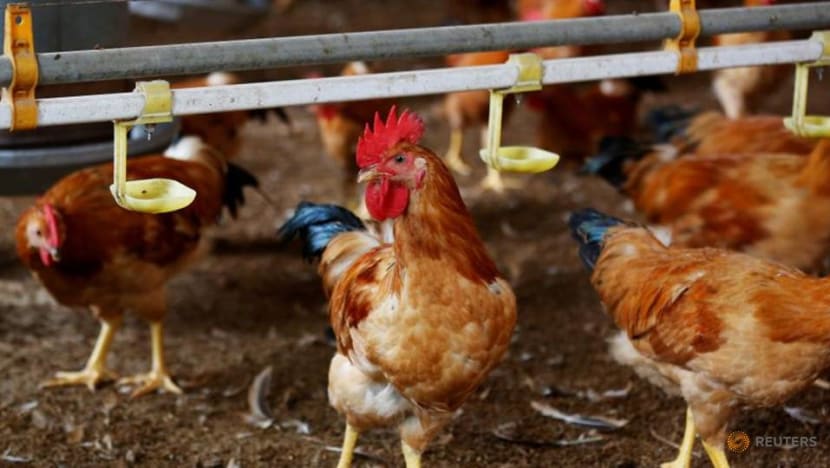Commentary: Singapore loves eggs but can we make production friendlier for hens?
Egg production is a highly industrialised process and a reality in egg-loving Singapore but are the animals suffering in the process? NTU’s William Chen explains.

FILE PHOTO: Chickens are seen at a farm in Hanoi, Vietnam on Apr 24, 2018. (Reuters/Kham)
SINGAPORE: If there is one thing Singapore diners really love – it is eggs.
In 2020, our per capita consumption was 388 eggs, up from 307 eggs in 2011. As a country, we ate 2.21 billion eggs last year.
This passion for eggs was elevated when cult restaurant Eggslut opened in Singapore on Sep 9 here.
To feed our love for eggs, the Singapore Food Agency (SFA) imports up to 74 per cent of the eggs with the remaining 28 per cent supplied by the three local chicken farms. Most of Singapore’s imported eggs come from Malaysia, followed by a small percentage from Australia, Japan and New Zealand.
Two weeks ago, it was announced that Japanese egg producer ISE Food Holdings (IFH) will set up Singapore’s fourth egg farm and when fully operational in 2026, it will produce 360 million eggs a year.
This will improve our food security, by reducing our reliance on imports, but PETA (People for the Ethical Treatment of Animals) has urged SFA not to proceed with the project because of the cramped conditions of IFH’s other egg farms.
Still, egg farming is a highly industrialised process geared towards efficiency. This is no different in Singapore.
SHIFT FROM FREE RANGE TO CAGES
People seem to reminisce of days of happier chickens. Indeed, some 60 years ago and before World War II, eggs were produced by hens in the US and Europe out in open fields.
They pecked at insects and seeds in the grass and spent their nights in the henhouses of family farmers. They are what we would call “free-range” hens.
Things changed when coccidiosis (a disease caused by a faeces-dwelling parasite) started attacking the hens. Hens had to be lifted off the ground and protected by cages. This change led to a better control of hens and eggs.
Soon, larger cages were built worldwide to cater for the increasing demand for eggs from a growing population. And this is what has evolved today.
Typically, each cage system can house 200,000 hens for large egg farms today. In Singapore, the few big operators, like N&N, have farms with at least one home to 500,000 hens at one point.
Free-range egg farming is simply unattainable for large-scale production especially for land-scarce Singapore. Therefore, how much space a hen has becomes important.
According to the Humane Society, today, caged hens in the US are confined in cages with 67 square inches of space for each. This is not enough for them to perform natural behaviours such as nesting, perching, dustbathing but this is the norm in most egg farms.
In the US, the Department of Agriculture (USDA) spells out clearly that cage-free hens should be allowed to move during their laying cycle – but it doesn’t mean they are not kept in cages.
The key thing is they are not kept in battery cages so in general they have more space – about 144 square inches. Many cage-free facilities are large warehouse barns and hens lay eggs inside these facilities.
However, cage-free may not necessarily mean a better environment, as the manure management would be more difficult to handle leading to poorer health of the hens.
Local egg farm Chew’s Agriculture for instance, offers cage-free eggs and these come from hens who live in a “specially designed aviary system”.
Singapore currently has three egg farms which produce about 28 per cent of demand today and the SFA monitors egg production carefully. It has updated good animal husbandry practices – and in September, published updated guidance on farm management in food safety and quality, animal health and welfare, environmental management among others.
TECH TO THE RESCUE
Given the space limitation and increasing demand, caged eggs are a reality, but technology can aid with animal welfare. A monitoring system using Internet of Things (IoT) platform employing Artificial Intelligence (AI) techniques can check on hens and automate processes.
At Seng Choon Farm for instance, temperature and humidity in cages are regulated by an automated cooling and ventilation system to keep hens stress free. Another local egg farm N&N Agriculture uses robot cleaners for cage washing, automation for feed loading, egg inspection and packing.
In view of the disruptive impact on the food supply chain by COVID-19, establishing a resilient local production system has become a national imperative.
For local egg farms, one potential weak link is the need to import day-old chicks (DOC) that lay our eggs.
IFH plans to host a DOC hatchery in Singapore, to raise chickens that will eventually parent more day-old chicks laying eggs for consumption, allowing Singapore to have its very own closed ecosystem of egg production and negating the need to import DOC altogether.
The DOC facility in Singapore may also help other local egg farms develop a more resilient egg production. With IFH contributing 22 per cent to local production and a doubling of capacity of the three existing local egg farms in the next five years, we would be able to meet almost 80 per cent of domestic demand in future.
MAKING EGG PRODUCTION SUSTAINABLE
Even after we’ve squared away egg production, another challenge is ensuring a resilient feed supply. As Singapore is not a crop producer, all chicken feed is imported and subject to supply chain disruptions.
With an estimated daily 100g of feed per hen, 180 tonnes of feed would be needed just for the 5 million hens from IFH operations by 2026.
The NTU Food Science and Technology Programme (NTU FST) has been working with SFA to replace a major ingredient, soybeans, with soybean residues, to replace the traditional feed. Soybean residues are by-products from food processing industry with a yearly 20,000 tonnes generated in Singapore.
Other sustainable practices are being worked on too. Waste materials from egg farms (feathers, manure, chicken blood) are used as compost as part of the partnership between the Leong Hup Group and NTU FST.
The hope is these innovations can lead to zero-waste egg farm operations with minimal environmental impact.
Finally, there is the nascent field of alternative eggs —which delivers familiar flavours, with a fraction of the carbon footprint—thanks to innovative Asian startups like Float Foods, OsomeFood and Next Meats.
Float Foods, a Singapore-based food technology start-up, produces plant-based eggs with legumes to substitute the egg yolk and egg white, which can be easily cooked - whether sunny side-up, overeasy or soft boiled.
Working with NTU FST and other solution providers, this local start-up aims to advance Singapore’s plant-based eggs to enhance Singapore’s food security and has plans with local F&B outlets to launch these offerings in October 2021.
While we cannot run away from the heavy industrialised nature of egg production, we can continue to have our eggs but without harming hens or the environment.
Of course, we can consider simply cutting back on our consumption of eggs or to embrace alternatives which may be just as delicious.
William Chen is the Michael Fam Chair Professor and Director of Food Science & Technology Programme, Nanyang Technological University Singapore.



















